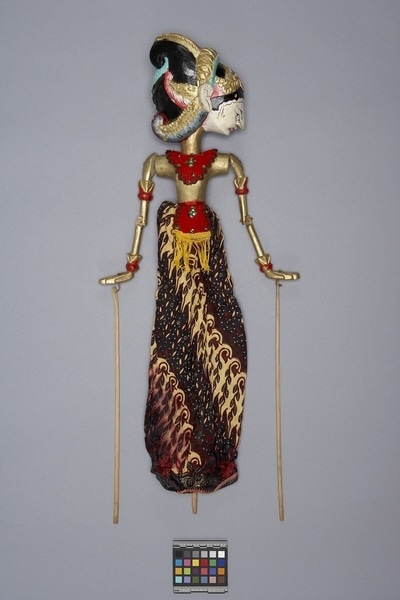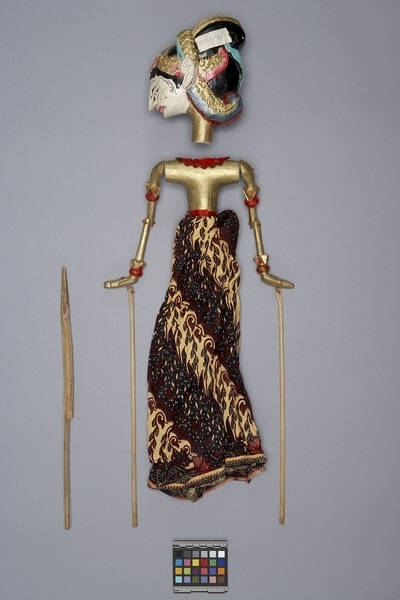Rod Puppet Item Number: Ib393 a-c from the MOA: University of British Columbia


Description
Three-dimensional male humanoid puppet: large head (part b) fits into body with skirt (part a), and a control rod (part c) with a long shaft that passes through the body and fits into the neck of the figure's head. The body has jointed arms, each with a long controlling rod attached. Green face positioned forward; bulging white eyes with red irises, and large wedge shaped nose. Parted lips red lips, white teeth; moustache, beard, hair, facial details in black. Simple upswept hair curl (gelung supit urang); red five petal flower at forehead, gold sumping, and green, yellow, and red dawala. Gold neck and torso with protruding chest. Arms with green and red ornaments at bicep and wrist. Hands held flat and bent at wrist. Small black chest covering with wavy brown trim, and red apron with brown trim and yellow frills at bottom. Both the chest covering and apron have pink bead and green sequin detail. Long batik skirt in blue, beige, and brown.
History Of Use
Javanese puppetry as an art form probably developed by the 11th century. Wayang golek puppets of western Java appeared during the 16th century. Originally the plays depicted Javanese mythology, but after the Indian conquest of Java the Hindu epics, Ramayana and Mahabharata, were incorporated into the cycles, which comprise about 200 plays. A dalang (puppet master) performs the plays to celebrate important occasions, usually in three acts, with vocal and instrumental accompaniment. Typically they serve a moral and religious purpose, and more recently, one of political commentary. Puppet possibly a manifestation of a standard character, varied for differences in mood, state, or role. Character might play the role of a noble youth, a minor prince, or an advisor. Specific role not identified. .
Iconographic Meaning
Each puppet is characterized by its wanda, a Javanese word which describes the specific mixture of elements of size, form, colour, ornamentation and carving. Green face may suggest calmness and youth. Red eyes, large features, corpulent body suggest aggressiveness and are not refined. Headdress is unusual in its simplicity, particularly with Bima type face. Significance of flower probably that of lotus. Headdress, position of hands, and batik skirt indicate a degree of nobility. Character not identified; possibly a deliberate variant of a standard figure.
Cultural Context
Theatrical performance.
Item History
- Made in Java, Indonesia
- Owned by Donald Bone before January 4, 1980
- Received from Donald Bone (Seller) and Museum of Anthropology Donations Fund (Funding source) on January 4, 1980
What
- Name
- Rod Puppet
- Identification Number
- Ib393 a-c
- Type of Item
- puppet
- Material
- cotton fibre, paint, fibre and wood
- Manufacturing Technique
- carved, woven, sewn, painted and tied
- Part A
- height 57.0 cm, width 17.5 cm, depth 7.0 cm
- Part B
- height 18.5 cm, width 9.0 cm, depth 14.5 cm
- Part C
- height 39.0 cm, width 2.0 cm, depth 1.9 cm
Who
- Culture
- Sundanese
- Previous Owner
- Donald Bone
- Received from
- Donald Bone (Seller) and Museum of Anthropology Donations Fund (Funding source)
Where
- Holding Institution
- MOA: University of British Columbia
- Made in
- Java, Indonesia
When
- Ownership Date
- before January 4, 1980
- Acquisition Date
- on January 4, 1980
Other
- Condition
- fair
- Accession Number
- 0586/0012 a-c